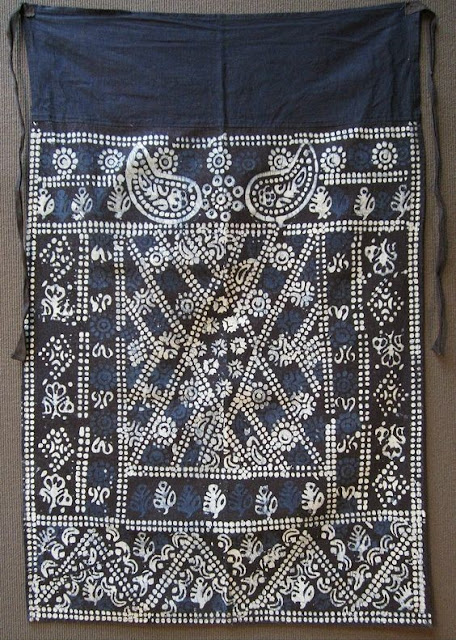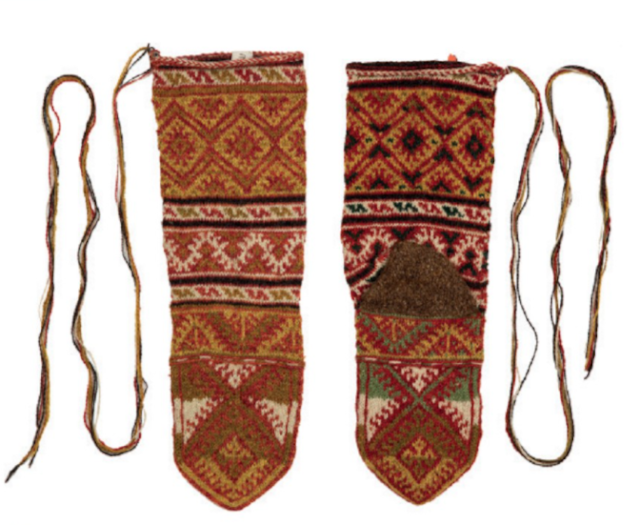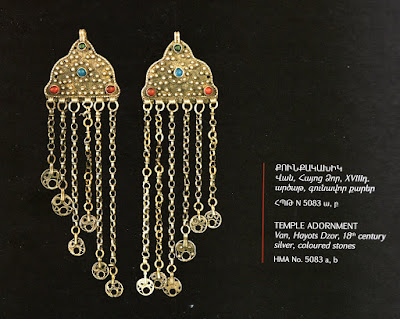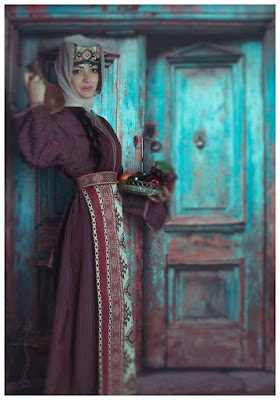Hello all,
Today I would like to talk about Western Armenian costume from around Lake Van. In old Armenia, the area adjoining the western shore of the lake was the province of Turuberan, and the area east of the lake was the province of Vaspurakan. The image above is of the Armenian singer Sirusho, who is wearing a headdress and jewelry from Vaspurakan. [The red lace top is not traditional.] The study of Western Armenian costume is made difficult by the genocide and expulsion of Christians by the Ottoman Empire in 1915. This is sometimes called the "Armenian Genocide", but in fact, Greeks, Assyrians / Chaldeans, Yazidis, and others were also affected. The motto of the time was "Turkey for the Turks!". In practice, other Muslim groups were tolerated, but non-Muslim groups were all targeted. [Even Armenians and Greeks who had converted were mostly left alone.] Besides being a historical tragedy, much cultural material has been lost.
This article is based on artifacts found in Museums around the world, mostly Russia and Armenia. I have been able to piece together the general costume of this area from these items. We are indebted to travelers who made it a point to collect these items. There are localities within this area which had unique costumes, but I will not address those in this article.
Women's Costume
On top of the undergarments, the first item to be put on are baggy pants, called ghanavuz or tiumban. The lower parts were often made of more ornate material, and the parts which are covered by other garments of plain material. The two legs were joined by a square gusset, and the waist was secured by a drawstring.
Here are a couple of examples from Bitlis.
On top of this was put the chemise, shapik. This was often of a red color, red being considered to be a powerful protection. The older chemises had open sleeves and no collar.
Here is an example from Bitlis, front and back. There is no shoulder seam, the sleeves are sewn in at right angles, and there are gussets and gores set in under the arms to provide fullness. Note the narrow ribbon sewn on top of the seam. This was also often considered to provide protection, especially if it was yellow.
The strings may have been to hike up the hem by tying them around the waist, thus making it easier to work. This can be seen in some old drawings, like this one by Arakel Padrik of a woman from Gavash on the south shore of Lake Van.
Here is an example from Bitlis.
Here is another example from the Van area. This kaftan was obviously meant to be worn under another one. This is indicated by the shoulder, upper back and upper sleeves being made from a cheaper material, areas that would not be seen when layered. Also the extra long sleeves which are slit up to the wrist. These would dangle from the cuffs of the kaftan worn over it. I believe that the reason that Armenian women were so fond of these dangling sleeves is that they flutter with the movements of Armenian dances, which are full of arm movements. In Vaspurakan, even the men sometimes had embroidered streamers attached to the cuffs of their dress shirts, for the same reason.
Note that this one has ties connected to the corners of the two front panels, which means that they would often have been tied up towards the back, like wings. If we look again at the drawing of the woman from Gavash by Padrik, it appears that her kaftan is also tied up in this manner. Here is another of his drawings, showing a woman from Van from the back.
Here is another drawing by Padrik, showing a woman from Van in a fancy jacket. Note that she also has a long fluttery undersleeve.
When a more dressy effect is desired, a dickey, krtskal or srtanots may be worn over the chemise and either over or under the kaftan. This has a strap which goes around the neck and fastens on top, and may have two straps attached to the bottom corners, which tie around the waist. It may be made of a fancier material, or be embroidered.
The focal point of this costume, as you can see from Padrik's drawings, is the apron, mezar or gognots. Here is an example of an ensemble from Vaspurakan. Here we can see the chemise, dickey, two kaftans, a necklace, a sash, and an embroidered apron.
When I first saw images of these aprons, I thought that they must be tapestry woven, but close examination leaves no doubt. Here is a closeup of a half apron with a design close to that shown above.
These two examples seem to be entirely executed in cross stitch. the second with some white beads sewn on top. Other examples also show the use of brick or bargello stitch, as in this example from Turuberan, the area around Moush.
And a look at the entire ensemble. Here you can see that the upper part of the apron was made of unembroidered red cloth, and was ornamented with sewn on cowries and buttons, some of which have been lost.
A second type of apron was also worn, also called mezar, whether in some localities or for less dressy occasions, or at a later date, i am not certain. This consisted of a length of cloth which was hung around the neck and covered the entire front of the outfit, much like a Russian apron. This example is from Alur [Alaköy] and is made of flower patterned wool with a cotton lining. There were likely two straps attached to the upper corners which tied under the arms.
Padrik has a drawing of a woman from Timar village in Vaspurakan. Today the Turks call it Gedikbulak. The word Timar refers to a specific type of fief granted by the Ottoman Sultans.
I believe that this drawing is of a young married woman. She is fully veiled, and yet wears a great deal of jewelry. You can see the pants, two layers of garments, one red and yellow striped which is either the chemise or an underkaftan, an overkaftan in red trimmed with yellow and green. The undergarment sleeves show at the cuffs, as well as at the hem. She is wearing this type of apron, a fez covered with kerchiefs, and jewelry around her neck, on the forehead over the fez, and on top of the kerchief covering the fez. She is wearing a white kerchief on top of a red one.
Here is an old photograph of a married woman in this outfit from Vaspurakan. Her chemise is apparently white, with a dark colored quilted kaftan over it, and a floral apron of this type. It clearly is not belted at the waist. She is wearing a minimum of jewelry, and it is clear that she is wearing a fez, a colored kerchief and then a white one on top.
A similar photo to the one above. Another studio photo, and indeed the woman on the right may be the same woman as in the photo above.
I wish to address one more type of apron found at least in Turuberan. Here is another drawing from Padrik of a woman from Moush. She is wearing this same outfit. The chemise is indigo, showing at the chest and cuffs, which are buttoned in the modern style. She wears two kaftans, as was common, and a single paneled apron. The apron is resist dyed in indigo, the white design having been drawn onto the cloth with paste, after which the cloth was dyed, and the paste removed to leave a white design on the cloth. This technique was used in many places, from Japan to Germany.
By the 19th cent. this technique had generally been replaced by knitting, which was introduced from northern Europe, where it had been used for many centuries. I do not have information as to whether mens' and womens' socks differed.
These would have been worn inside moccasins made of leather. These would be tied up with cords around the ankle and leg.
Here are a couple of stills from an old video of a Vaspurakan dance troup. The men are wearing moccasins with corded tops, and the women slippers with cloth uppers. I am not sure how old this is, or how traditional the footwear.
Shatakh, where the front is covered with velvet and then has metal ornaments sewn on.
In Moks, the front of the cap, here called glkhadzhard, is heavily sewn with beads and other ornaments.
These are often made of precious metals, and could be very costly. Here is an example from Vanakh, between Bitlis and Zgerd.
Here is an extraordinary example. It appears that a girl could not afford to buy a tasak, and so made her own from materials that she had access to.
In this case, a wrap would be used to cover it. A. Here is an example of a wrap that would be tied around the cap. The metal ornaments would hang over the forehead and the beads would frame the face.
The wide wooden hoop was covered with fabric, then had metal ornaments sewn on. The short veil that covers the back of the head has a fringe of glass beads sewn onto it. There are many other possibilites. Temple pieces might be hung from the sides of the cap, like these from Van.
Many other pieces of jewelry were worn, rings, bracelets, necklaces, earrings, and items that English has no word for, diadems hanging from the top of the cap over the forehead, braid pendants, ornaments that hook on either side of the chest, chains that pin or hook to the back of the veil, etc. I do not have the time or knowledge to go into them all.
When all the ornaments that she chose to wear that day were in place, the woman would then attach the underveil. This would hang from the top of the cap or hoop and cover the back of the head.
In Van, these kerchiefs, glkhashor, were embroidered on the corner which hung down. A fringe of beads and tassels was also added. Here are some examples.
This last item is unidentified in the text, but the embroidery is similar. This next item is an embroidered corner of a boy's neck kerchief. In both cases the embroidery is very similar.
When going out, a veil, or another kerchief, or more than one, would be worn on top of the headdress, in some cases it would be wrapped around the neck, or even over the mouth, as we saw in the old photos above.
Here we see a dickey with shamshik attached. This one would clearly have been worn on the outside of the kaftans
The red chemise is visible, a striped kaftan has the front panels pulled back and tied, showing the dark lining. She is wearing a srtanots on the outside of the kaftan, several kerchiefs tied around a hoop on her head, and the distinctive Bitlis apron.
Just a couple of old photographs from Bitlis. With embroidered apron, of a somewhat different style, it seems that each apron was expected to be different. The woman on the right is wearing two garments with sleeves, rolled up. The woman on the left has oversleeves to protect her kaftan, and both are wearing srtanots on top of their kaftans.
These women are wearing plain aprons of the same cut, both are wearing plain white srtanots, and the girl on the right is wearing a fez with tasak.
Back to the general outfit, here are some ensembles in the collection of the Museum in Yerevan.
And a photograph, also from Moush. A beautifully patterned kaftan in ikat, embroidered apron and srtanots, inkle woven sash and highly ornamented headdress.
An old photo of women working at preparing for a wedding in Van. The aprons are visible, but not well. The other parts of the everyday costume can be seen. Note the various materials used for the kaftans. The woman seated in the center has an impressively embroidered srtanots.
Source Material:
Nazik Avagyan et al, 'Armenian Costume 18th - 19th centuries', Yerevan, 2014
L.S. Gushchan et al, Treasures of Western Armenia', St. Petersburg, 2015
Arakel Patrik, 'Armenian National Costume from Ancient times to Our Days', Yerevan, 1967
Julia Mutlu, 'Traditional Armenian Costumes', Istanbul, 2011
Tatyana Razina et al, 'Folk Art in the Soviet Union', Leningrad, 1990
Mehmet Oezel, 'Turkish Folkloric Costumes', Ankara, 1992
O. O. Hasiuk et al, 'Khudozhne Vyshyvannia', Kyjiw, 1986






















































































































































The ladies must have positively shimmered, what with the fluttering sleeves and the chains and dangles! And I am most grateful for the many clear closeup pictures - very inspiring. Thank you for another excellent post. Charlotte in California
ReplyDeleteWow! This is just what I needed! I am trying to make a reproduction, and it is sooo hard to find pictures of original garments. So far I am a bit more than halfway through hand embroidering the apron -- I have made a lot of the rest of it, but not the caftans or the sash. Thank you so much for the fantastic pictures and summary!
ReplyDeleteThank you this is great. Can you tell me, if you were standing in the street in 1914 how would an Armenian look different from a Turk? Less face covering? Hair braided, but shown? Did Turkish women wear an apron? Or was it the colors? Were the Turks darker or lighter?
ReplyDeleteThank you
Sandi
Hello Sandra, I am sorry that I cannot help you. Turks were not common in this area, however. Besides the Armenians, most people were Kurds. There were also Yezidi, Assyrians, Chaldeans, etc. I do not know of any general rules about dress. Certainly in any particular locality they would be able to recognize each other by many details, but these would vary from place to place. I have read that the facial veils worn over the lower face covered the nose for Turks, and did not for Armenians, but I have seen photos that did not follow this rule. Generally Green was only worn by Muslims. I do not have much information on Turkish costume, except for upper class Ottoman Costume, but that was commonly copied by many city people. I do not think that there is a short easy answer, but varied by region.
Deleteİyi akşamlar burun kapama müslüman lar yapar iç içe yaşandığı için kıyafetler de benzerlik var.Yesil renk de Müslümanlar için.Dokumada şekil farklılıkları var ama genel olarak çok yakınlar ben Tokat lıyım benzerlik var.Ermeni soykırımı diye bir şey yok.
DeleteThank you for your information. I had heard that whether the nose is covered or not was important.
DeleteIt is extremely clear that the Armenians, as well as the Assyrians and Greeks were targeted, killed and driven out. There were many of them living in what is now eastern Turkey, and now there are not. They were deliberately driven from their homes and very many were killed. If this is not genocide, what would you call it?
Also, sorry to be a pest, but how many layers would they wear if it was hot outside?
ReplyDeleteThank you
Sandi
I do not have information on this, however, bedouins and other modern people wear full garments when out in the sun. They seem to regard their clothing as being portable tents, providing shade.
DeleteHey, thank you. This was very informative and has a lot of pictures. :)
ReplyDeleteThis is just a representation of how Turkificited Armenian culture within ages. Most of the clothes that you mention are brought by Turks to Anatolia since Armenians were used to have different clothes in Eastern Roman Empire era. No Anatolian woman wore pants (called "şalvar" nowadays) back then. Also the three piece kaftans are totaly introduced by Turks. Many other Turkic people have similar clothings and motifs, you can add many examples. So, my point is that it is a misconception when you talk about Armenian culture but totaly exclude affects of Turks. Just mentioning they are somewhat similar doesn't provide enough interpretation of this cultural values and their origins. That approach doesn't make us understand the meaning of these clothes or where they are coming from or how they evolve to a particular style.
ReplyDelete*Turkificated
DeleteI want to see how Armenians in mush dressed the men
ReplyDeleteThank you for an excellent post. I've been trying to get a handle on traditional Armenian clothing for the Van area just prior to 1914. This is the best source I've found yet. Have you any information and/or examples of traditional wedding attire? Thanks in advance for any help you provide.
ReplyDeleteNice post about Armenia Culture
ReplyDeleteThanks for sharing
Armenia Tour Package
Hello. This is not Armenian culture. What they stole are Turkish and Azerbaijani clothes, jewelry, and carpet motifs. This culture existed before the Armenians were resettled in the Caucasus.
DeleteThis culture has existed in the South Caucasus for thousands of years. The Hays, who were under the protection of the Vatican, were later called Armenians thanks to them. And as a nomadic people, they were scattered all over the world.
DeleteThey call themselves Hay, not Armenians. The word Armenian is the name given to them by the Vatican. The resettlement to the South Caucasus began in the 17th-18th centuries - by the Russian Tsar Peter I.
DeleteIn addition, thousands of Armenians were resettled from the Ottoman Empire to the South Caucasus and South Azerbaijan at that time. After that, these Armenians committed mass murders in these areas.
Delete... they began to commit massacres, reducing the number of local populations and declaring to the world that they had lived in these areas for thousands of years.
DeleteThis comment has been removed by a blog administrator.
DeleteThey have unknowingly proven this. If they had lived in those areas for thousands of years, they would not have begged the Vatican for protection.
DeleteUnlike the 1915 genocide, the mass killings committed against Azerbaijanis on March 31, 1918, is not a fantasy - it is reality. Find out for yourself by typing March 1918 genocide on Google.
DeleteIf you want to know that the Azerbaijani people are truly one of the first peoples in the Caucasus, you can also read about the Azikh cave. The lower jawbone of an 18-22 year old woman was found in this cave.
DeleteTraces of hearth ashes and various animal bones were also found. The exhibits I mentioned are kept in the Azerbaijan State History Museum. Several such caves have been discovered in Azerbaijan.
For example, I can cite areas such as the Dashsalahli and Damjili caves in the Gazakh region, the Qazma cave in Nakhchivan, the Gobustan rock carvings in Absheron, etc.
Unfortunately, as a result of the unimaginable crimes, terrors and genocides committed by the Armenian-Hays, such cultural sites have also been destroyed and looted. Some of them have been stolen and distributed to the world.
It is presented as Armenian-Hay culture. One of the acts of vandalism was committed in the Azikh cave, which I mentioned. After the occupation of 1993, this cave was destroyed and used as an arms depot.
After the liberation from occupation, the archaeological layers of the Azikh cave were very roughly studied (as a result of the Armenians sending foreign scientists to the area) and destroyed.
This is just part of what the Armenian-Hays have done. They have committed genocide against cultural monuments. You can't even imagine what they have done to people.
To avoid falling into their trap of lies, I can recommend you the easiest research platform: visit the "belə belə işlər" channel on YouTube and get to know the truth (use subtitles)
https://youtube.com/@belebeleisler?si=h9p7_JvEh5adrnR9
DeleteThis is the link to the channel I mentioned. Anyone can go and watch. Enjoy watching 🌹
Where can we find the source material?
ReplyDeleteI am doing my own research and need sources like this but can't find these books online/in libraries. Thanks!
Wikimedia
Delete